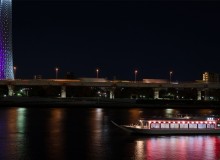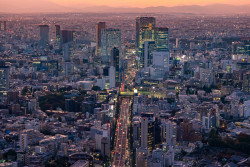
December 3, 2015
Cycling Embassy of Japan
Aussie Byron Kidd works to lift local bike culture
Arriving two decades ago as a budding software engineer, Byron Kidd soon found a place among Tokyo’s two-wheeled hordes. Mapping the Kanto plain by bike, Kidd would cycle 100 kilometers a day all over the mountains around Tokyo, even logging a season with Japan’s professional mountain bike league. Years of guiding cycling tours, including Santa-clad Night Pedal Cruising shenanigans, led Kidd to a committed role as a cycling evangelist for his adopted country. Metropolis talked to him about his new Cycling Embassy of Japan, Japan Cycling Handbook, and the mountain bike vs. mamachari conundrum.
How conscious are the Japanese about cycling relative to other countries?
Cycling in Japan has always been a popular form of transport. The design of Japanese neighborhoods, combined with excellent public transport and the high cost of private car ownership, makes the bicycle the most convenient way to make short trips. Yet few Japanese realize that Japan is right up there as one of the world’s great cycling nations. It is my aim to promote this fact amongst the Japanese people.
What challenges does bike culture face in Japan?
With a recent rise in accidents involving bicycles, police have become much more strict on cyclists, and the image of cycling is taking a beating. Any action that makes cycling more inconvenient or expensive will result in a drop in the number of cyclists, and in a world where cities are actively promoting cycling, building cycling infrastructure, and trying to increase cyclist numbers, Japan should be careful that its actions do not do the exact opposite.
How can cycling awareness here be raised?
The first step in preserving Japan’s cycling culture is to make people aware of what an important part the bicycle plays in [people’s] lives, followed by demonstrating that Japan is already leagues ahead of most of the world when it comes to utilitarian cycling, and that cycling should be supported and promoted as it brings enormous benefits to society, includ[ing] environmental, health, economic, and social benefits. Supporting cycling in the city must be on every council agenda around the country going forward.
What do you make of the fixie bike boom in Japan?
The fixie boom has been both a blessing and a curse. As fixies have been swept up in the fashion movement, a whole spectrum of society that would have otherwise not considered owning a bicycle have flocked to single-speed bikes. On the other hand, the fixie boom brought a flood of inexperienced riders to the streets and sidewalks of Japan. As a result, the number of accidents between pedestrians and cyclists increased about the same time as the fixie craze took off, prompting police to hold special road safety campaigns in which they came down hard on all cyclists based on the dangerous acts of a few.
What is the ideal bike for a Tokyo gaijin?
When I use the term “cyclist,” I’m referring to everyone who rides a bicycle: moms, dads, businessmen, kids, the elderly. Therefore, it’s hard to pin down the ideal bike for the Tokyo gaijin. As an everyday commuter, I recommend a cross or hybrid bicycle—one that is light and has narrow, almost slick tires like a road bike, but flat handlebars and a more upright seating position, which is more comfortable and safer for urban cycling. Add to this a rear rack, some panniers, or a folding basket, and you’re ready to take on shopping trips or cycling to picnics in the park.
Set us straight: is it legal to ride on the sidewalk in Tokyo or not?
It’s legal to ride on the sidewalks in Japan, except for where it is not—that is the most concise answer I can give. The bicycle is classified under Japanese [law] as a light vehicle, and as such is required to use the road. In the early 1970s, the Road Traffic Act was amended to allow cyclists to ride on specifically marked sidewalks—and from there, the lines became blurred. Regardless of the law, I believe cyclists should be able to ride where they feel safe. But when cycling on the sidewalk, they should yield for pedestrians at all times, as the sidewalk is the domain of the pedestrian.
The Cycling Embassy of Japan. http://cycling-embassy.jp. The Japan Cycling Handbook is available as a download from the website.







